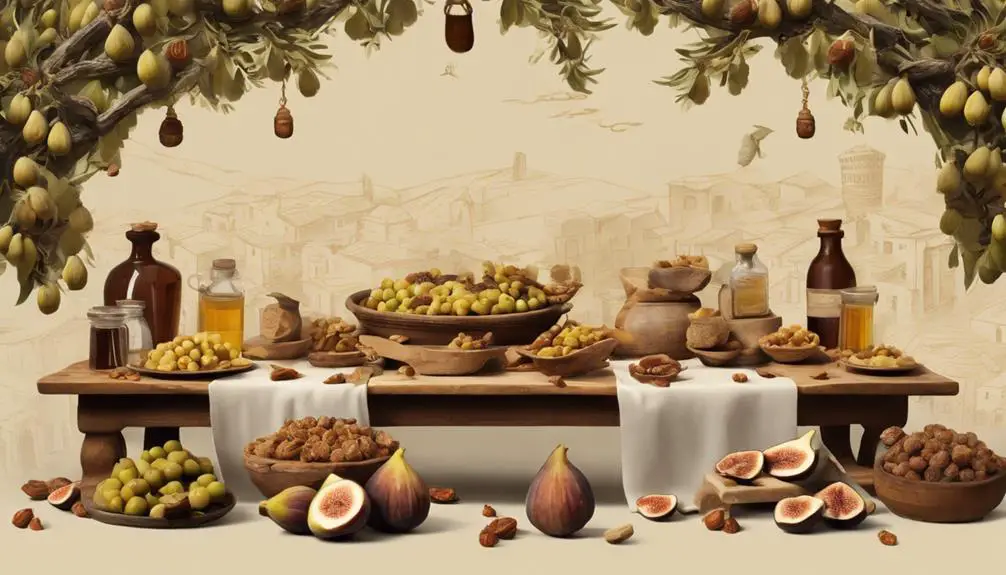Sugar's absence in biblical texts opens a sweet mystery into ancient diets and cultures, beckoning a deeper exploration.

Sugar in the Bible
You might've thought Moses brought tablets down from Mount Sinai inscribed with diet plans, but surprisingly, sugar doesn't make a cameo in the Bible.
As you explore the historical context of sweeteners, you'll find sugar's absence in biblical texts quite telling.
The common sweeteners of those times, and their dietary implications, reveal a fascinating contrast to today's sugar-laden diets.
By comparing these ancient practices with other cultures, you'll uncover a broader understanding of humanity's sweet tooth.
So, let's take a step back into history, and you might just find what sweet secrets the past holds for our present.
Key Takeaways
- Sugar as we know it was not present in biblical times; honey and fruits were the primary sweeteners.
- Biblical references to sweetness often symbolize abundance, health, and spiritual richness, primarily using honey.
- The evolution of sweeteners from natural sources like honey to refined sugar reflects significant technological and economic shifts post-biblical times.
- Understanding the use of sweeteners in the Bible can inform current debates on natural versus processed sugars in diets.
Historical Context of Sweeteners

Throughout history, various cultures have utilized a myriad of sweeteners, from honey in ancient times to the refined sugar that dominates modern cuisine, reflecting not just culinary preferences but also the socioeconomic dynamics of their periods. Honey, notably, held profound symbolism across civilizations. It epitomized abundance, health, and prosperity. In the ancient world, honey's value was more than gastronomic; it was spiritual, often used in religious rituals to symbolize sweetness in life and the afterlife. This sacred significance elevated honey beyond a mere food item, embedding it deeply in the cultural and religious fabric of societies.
Transitioning to sugar, the narratives surrounding its trade routes reveal much about the historical shifts in economic power and technological advancement. The sugar trade routes, spanning across continents, weren't merely channels for the commodity's physical movement. They were conduits of cultural exchange, technological innovation, and, unfortunately, exploitation. The intricate web of these routes showcases how sugar transitioned from an exotic luxury to a staple, underscoring the globalization of taste and the commodification of sweetness. The emergence of sugar as a dominant sweetener also marked significant socioeconomic transformations, influencing labor practices, trade relationships, and even colonial endeavors.
Your understanding of sweeteners' historical context, particularly the roles of honey symbolism and sugar trade routes, enriches your comprehension of their broader societal implications. It's a fascinating journey through time, exploring how these sweet substances have been more than just ingredients; they've been powerful symbols, economic drivers, and catalysts for change.
Sugar's Absence in Biblical Texts

Despite its prevalence in modern diets, sugar finds no mention in the biblical texts, highlighting a significant cultural and dietary divergence from contemporary times. This absence isn't merely an oversight but speaks volumes about the socio-economic conditions, trade practices, and dietary habits of biblical times. The lack of sugar in these sacred texts opens up an avenue for deeper textual interpretations and understanding of the symbolic meanings attached to the foods that are mentioned.
When you delve into the biblical texts, seeking references to sweeteners or sugar symbolism, you're met with a conspicuous silence on sugar. This void is intriguing and prompts several considerations:
- The Symbolic Role of Honey: In contrast to sugar, honey often symbolizes abundance and prosperity, perhaps hinting at what was valued and accessible.
- Fruit as Natural Sweeteners: The frequent mentions of fruits, such as figs and grapes, could imply a reliance on these natural sources for sweetness.
- The Absence as a Socio-Economic Indicator: This lack of mention may reflect the limited trade relations and agricultural practices of the time, where sugar cane wasn't a known or easily accessible commodity.
- Cultural Dietary Practices: It suggests a diet that was less reliant on processed foods and more on what was readily available in the natural environment.
This absence of sugar in the biblical texts isn't just a trivia point but a window into the historical and cultural context of the times. It challenges modern readers to reassess their understanding of sugar symbolism and the complexities of textual interpretations within a historical and cultural framework.
Common Sweeteners in Biblical Times

In examining the sweeteners used during biblical times, it's essential to understand that honey and fruits like figs and grapes served as the primary sources of sweetness in the diet. Honey, in particular, was highly valued not only for its sweetness but also for its scarcity and labor-intensive collection process. Honey harvesting required meticulous planning and a deep understanding of bee behavior. Ancient beekeepers would have used simple tools to collect honey from wild hives, often located in rocky crevices or hollow trees. This endeavor was risky, as it exposed the harvesters to stings and potential falls, highlighting the precious nature of honey as a sweetener.
Date cultivation, another significant source of sweetness, showcases the agricultural ingenuity of the time. Dates, with their high sugar content, were a staple in the diet and could be consumed fresh or dried, providing a reliable source of sweetness year-round. The cultivation of date palms demanded a thorough knowledge of irrigation techniques, as these trees thrived in the arid climates of the Near East. The process of planting, nurturing, and harvesting dates was a testament to the ancient world's ability to adapt to and modify its environment to secure a consistent supply of sweet foods.
These practices of honey harvesting and date cultivation underscore the lengths to which ancient societies went to procure sweeteners. Despite the absence of refined sugar, the people of biblical times developed sophisticated methods to satisfy their taste for sweetness, relying on the natural bounty of their surroundings.
Dietary Implications of Ancient Sweeteners

ARTICLE TITLE: Sugar in the Bible
PREVIOUS SUBTOPIC: 'Common Sweeteners in Biblical Times'
CURRENT SUBTOPIC: 'Dietary Implications of Ancient Sweeteners'
Often, the consumption of natural sweeteners like honey and dates significantly influenced the nutritional profiles of ancient diets. These sweeteners, while providing essential calories, also brought along a host of nutrients absent in their modern equivalents, such as refined sugars. Let's delve into the dietary implications of these ancient sweeteners:
- Nutritional Density: Honey, a primary sweetener, wasn't just a source of sugars; it contained vitamins, minerals, and antioxidants. Ancient honey harvesting techniques ensured the preservation of these nutrients, unlike the heavily processed honey we often find today.
- Digestive Health: Dates and figs, rich in dietary fibers, contributed to better digestive health. Their consumption helped in preventing the ailments that are now common due to the lack of fiber in modern diets.
- Energy Levels: The natural sugars in these sweeteners provided a more sustained energy release compared to the sudden spikes caused by refined sugars. This is because, along with sugars, these natural sweeteners contained other macro and micronutrients that moderated energy absorption.
- Disease Prevention: The antioxidants found in honey and the minerals in dates played a role in disease prevention. Modern equivalents, by contrast, often contribute to health issues due to their pure, concentrated sugar content and lack of accompanying nutrients.
Understanding the dietary implications of ancient sweeteners like honey and dates reveals a stark contrast with their modern equivalents. The shift from nutrient-dense natural sweeteners to refined sugars could be contributing to contemporary health challenges, underscoring the value of these ancient dietary choices.
Cross-Cultural Comparisons of Sweetness

Exploring the dietary implications of ancient sweeteners illuminates the nutritional wisdom of past cultures; now, let's examine how different societies have historically valued and integrated sweetness into their diets. The journey from natural sweeteners like honey and dates to the complex world of modern sweetener evolution reveals not just technological advancements but also shifts in global sweetness perceptions.
Culture |
Preferred Sweeteners |
|---|---|
Ancient Egyptians |
Honey, Dates |
Medieval Europe |
Honey, Molasses |
Modern America |
High-fructose Corn Syrup, Sugar |
In ancient times, sweetness was not just a matter of taste but also of health, spirituality, and even social status. The ancient Egyptians, for example, prized honey not only for its sweetness but for its healing properties, using it in both culinary and medicinal contexts. This contrasts with Medieval Europe, where honey and molasses were the dominant sweeteners until the introduction of cane sugar revolutionized diets and economies.
The modern era has seen a dramatic shift towards processed sweeteners, with high-fructose corn syrup becoming prevalent in America due to its cost-effectiveness and extended shelf life. This shift reflects broader trends in global sweetness perceptions, with an increasing preference for highly sweetened foods despite growing health concerns.
Analyzing these cross-cultural comparisons highlights the intricate relationship between culture, economy, and the evolution of sweeteners. It's clear that as societies have evolved, so too have their sweetening methods, with each era and region developing preferences that reflect their unique circumstances and values. Understanding this evolution not only enriches our knowledge of history but also informs current debates around diet, health, and cultural identity.
Frequently Asked Questions
How Did the Perception of Sweetness and Sugar Evolve in Biblical Interpretations Over the Centuries?
You're exploring how sweetness and sugar's role shifted in biblical interpretations over time. Initially, sweetness symbolism tied closely to cultural tastes, embodying purity and divine favor.
As centuries passed, these interpretations evolved, reflecting broader societal changes. Scholars now analyze this evolution, noting how historical context influenced biblical readings.
This analytical approach reveals the complexity of interpreting sweetness, showing it's more than a simple taste—it's a deeply ingrained cultural and religious symbol.
Are There Any Specific Biblical Figures Who Are Notably Associated With the Cultivation or Consumption of Sweeteners?
You won't find biblical figures directly linked to sugar cultivation, but honey and fig delicacies stand out. Samson's encounter with a lion and the subsequent honeycomb highlights honey's significance.
While not growers, their consumption of such sweeteners hints at a cultural appreciation. Analyzing these instances offers a nuanced view of how sweetness was valued and symbolized, suggesting a complex relationship with these natural sweeteners beyond mere sustenance.
How Do Modern Religious Dietary Laws, Derived From Biblical Texts, Address the Consumption of Sugar and Sweeteners?
Navigating the sweet waters of modern religious dietary laws, you'll find that interpretations vary widely. These guidelines, rooted in ancient texts, now grapple with contemporary issues like sugar and sugar substitutes. Scholars meticulously analyze passages to advise on consumption, balancing health with tradition.
Modern interpretations often encourage moderation, considering both natural sugars and artificial sweeteners. This analytical approach ensures that dietary advice remains relevant, blending age-old wisdom with today's nutritional insights.
Can the Lack of Direct References to Sugar in the Bible Be Linked to Specific Health or Spiritual Beliefs of the Time?
You're diving into the lack of sugar mentions in historical texts, aiming to link it to health or spiritual beliefs.
Given sugar's scarcity, its absence could reflect limited access rather than a deliberate health choice.
However, exploring health implications, you might find that ancient wisdom inadvertently protected communities from sugar's potential harms.
This absence, therefore, might hint at an unintentional alignment with modern understandings of sugar's impact on health.
What Role Does the Symbolism of Sweetness Play in Biblical Parables and Teachings, Outside of Its Dietary Context?
In biblical parables and teachings, the symbolism of sweetness transcends mere taste, embodying divine rewards and spiritual fulfillment. It's no coincidence that sweetness metaphors enrich stories, illustrating life's deeper meanings.
This usage isn't just about flavor but about highlighting the contrasts between life's hardships and the sweetness of divine truth and rewards. Analyzing these symbols, you'll find they intricately weave spiritual lessons into everyday experiences, offering profound insights into faith and morality.
Conclusion
In conclusion, you've journeyed through the historical intricacies of sweeteners, noting sugar's conspicuous absence in biblical texts.
You've explored the common sweeteners of biblical times and their dietary implications, alongside cross-cultural comparisons.
It's clear that 'variety is the spice of life,' and this adage holds true for ancient sweeteners.
Analytically, it's evident that the ancients' dietary choices weren't only a matter of availability but also of cultural and health considerations, revealing a sophisticated understanding of nutrition and taste.



Sign up